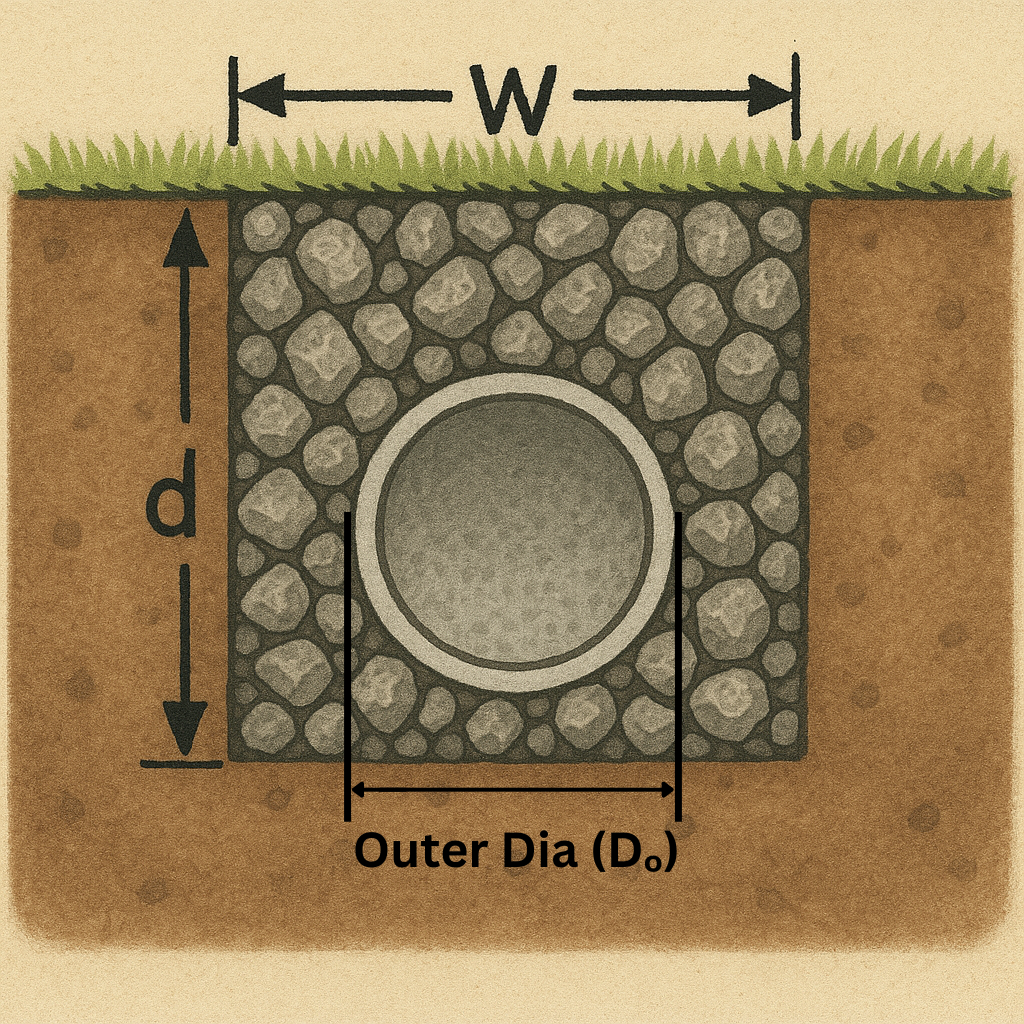French Drain Gravel Calculator
Enter Your Trench and Pipe Measurements
Pipe Details
Calculation is based on average density of 1,600 kg/m³.
Calculation Results
Gravel Volume
0.00 m³
Gravel Weight
0.00 t

To find the Length (L), place the zero end of a tape measure at the trench’s inlet, run it straight along the bottom to the outlet, and record the distance.
How Does This Calculator Work?
This tool computes the volume and weight of gravel required to fill a French drain trench around a perforated pipe. You simply enter your trench dimensions (length, width, depth), select the pipe size (or enter its outer diameter manually), and optionally adjust the gravel density. Under the hood, the calculator:
- Converts all measurements to one unit for consistent math.
- Calculates the cross-sectional area of the trench.
- Subtracts the pipe’s cross-sectional area to get a net gravel area.
- Multiplies by trench length to get total gravel volume.
- Applies the specified density to compute the weight.
- Converts the results into your chosen volume and weight units.
Why Use a Gravel Calculator for Your French Drain?
Estimating the gravel needed for your French drain often leads to over-ordering or under-ordering gravel, which can be costly and time-consuming. This calculator ensures you buy exactly what you need, reducing waste and saving money.
Choosing the Right Trench Dimensions
Standard French drain trenches are typically 6 to 12 inches (150–300 mm) wide and 12 to 24 inches (300–600 mm) deep. Adjust based on soil type and desired drain capacity.
Pipe Sizes and Gravel Density
Perforated pipe sizes vary from 2″ to 48″. Most residential drains use 3″ or 4″ PVC pipe. Gravel density defaults to 1,600 kg/m³, but you can adjust if you have a different stone type. You can also select the pipe size from the dropdown to auto-populate the outer diameter, or choose to enter the outer diameter manually.
Unit Conversions
All inputs and outputs support multiple unit systems (metric and imperial). Feel free to switch between cubic meters, cubic feet, yards, kilograms, tonnes, or pounds to suit your project.
Tips & Best Practices For Choosing Gravel For Your French Drain
- Round up your final volume or weight to account for compaction and spillage.
- Ensure your trench is level and properly sloped toward the outlet.
- Wrap your perforated pipe in filter fabric to prevent clogging.
Frequently Asked Questions (FAQs)
What density value should I use for gravel?
Most crushed stone and gravel have a density around 1,600 kg/m³ (about 100 lb/ft³). If you know your supplier’s exact density, you can check “Enter density manually” and input that number. If you are not sure about the density, just keep it at 1,600 kg/m³.
Why does the calculator subtract the pipe’s cross-sectional area?
The trench must hold both pipe and gravel. Subtracting the pipe’s area ensures you calculate only the volume available for gravel, avoiding over-ordering stone you don’t need.
Which pipe size is right for my project?
Residential French drains commonly use 3 in or 4 in perforated PVC pipe. Larger diameters (up to 48 in) suit commercial or high-flow applications. Pick the nominal size closest to your pipe brand, or enter the exact outer diameter if you have non-standard piping.
How much extra gravel should I order for waste and compaction?
While this calculator gives exact theoretical volume, real-world factors (compaction, spillage, uneven trench walls) mean you will often want 5–10% more than the calculated amount. Round up your final order to the next full cubic yard or tonne.
Can I use different units for measurement?
Yes. All inputs and results support both metric (m, cm, mm, kg, t) and imperial (in, ft, yd, lbs) units. Switch units at any time to match your plans or supplier’s ordering system.
What trench dimensions are recommended?
A typical residential French drain trench is 6–12 in (150–300 mm) wide and 12–24 in (300–600 mm) deep. Install a gentle slope of 1 in per 8 ft toward the outlet for proper drainage.
Why wrap the pipe in filter fabric?
Filter fabric prevents soil and sediment from clogging the perforated pipe and surrounding gravel, ensuring long-term performance. Lay the pipe on fabric, backfill with gravel, then wrap the fabric over the top before covering with soil.
How can I verify my results?
Compare the calculator’s output with supplier bag counts (e.g., 50 lb or 1 cu ft bags) or bulk price sheets. If you order bulk material by the ton or cubic yard, convert your final gravel volume and weight into those units to match your supplier’s quoting system.